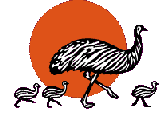
Home
Atlas Info
Maps
Contacts
Register! Links
News & Events
Vetting etc.
NT Birdlist


Search
Login

|

|
Binoculars can be considered essential for birdwatching. 7x35 or 8x40 binoculars give good close range viewing usually with a wide angle of view. They are especially suitable for those still learning to pinpoint the bird in their binoculars. Whilst we won't recommend particular brands, it is usually the case that the more you can pay the better the binoculars will be. Some of the main considerations in purchasing binoculars are:
|

|
Spotting Scopes are not essential for general birdwatching. They are invaluable though for watching waterbirds, and can be especially useful in helping sort out the more difficult to identify species or getting good close views of rarities. If you're looking at getting a Spotting Scope, consider:
|

|
A field guide is essential if you want to put names to the birds you see. In addition to illustrations and descriptions of the birds most field guides give useful information for beginning birdwatchers. This can include tips on how to identify birds and introductory information about binoculars or telescopes. Generally there is also a diagram of a bird with its parts named, a good help when writing field notes of a bird seen. There are three 'modern' Australian field-guides that are widely used. Each has its special merits.
|

|
A notebook and pen(cil) can be considered essential birdwatching equipment. In the notebook record details for each birdwatching session. At a minimum include date, time and locality together with the list of birds recorded. It can be useful to take notes on the habitat and any special conditions such as weather, height of tide (if locality is coastal) etc. Sightings of rarities or of birds where identification is uncertain should be recorded with as much information as possible. Include as much as you can about:
Detailed notes of breeding records are also invaluable and can be submitted to the Nest Record Scheme. |
| Copyright 1999, 2000. | |